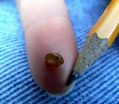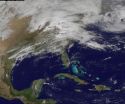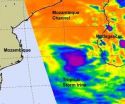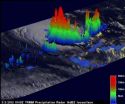(Press-News.org) PITTSBURGH—The origin of an important type of exploding stars—Type Ia supernovae—have been discovered, thanks to a research team at the University of Pittsburgh.Studying supernovae of this type helps researchers measure galaxy distances and can lead to important astronomical discoveries. A paper detailing this research has been accepted for publication in Astrophysical Journal Letters.
Principal investigator Carlos Badenes, assistant professor of physics and astronomy in Pitt's Kenneth P. Dietrich School of Arts and Sciences, detailed the ways in which his team used the Sloan Digital Sky Survey—a collection of multicolor images and more than a million spectra covering more than a quarter of the sky—to determine what kinds of starts produce Type Ia supernovae explosions.
"We knew that two stars had to be involved in such an explosion, and that one of them had to be a white dwarf," says Dan Maoz, professor of physics and astronomy at Tel-Aviv University in Israel and coauthor of this soon-to-be-published paper on the discovery. "But there were two possibilities for what the second star is, which is what we sought to discover."
According to Badenes, there were two potential outcomes for the star's type. It could be a "normal star," like the sun, or it could be another white dwarf, which is a smaller, more dense faint star composed of electron-degenerate matter. The team suspected the latter, as two white dwarfs within the same star system would revolve around one another at half a million miles an hour, speeding up and getting closer and closer until one day they merge, most likely producing the fireworks of Type Ia supernovae.
"There were obvious reasons to suspect that Type Ia supernovae come from the merging of a double white dwarf," says Maoz. "But our biggest question was whether there were enough double white dwarfs out there to produce the number of supernovae that we see."
Because white dwarfs are extremely small and faint, there is no hope of seeing them in distant galaxies. Therefore, Badenes and Maoz turned to the only place where they could be seen: the part of theMilky Way Galaxy within about a thousand light years of the sun. To find the star's companion, the team needed two spectra to measure the velocity between the two. However, SDSS only took one spectrum of most objects. The team decided to make use of a little-known feature in the SDSS spectra to separate each one into three or more subspectra. Although the reprocessing of the data was challenging, said Badenes, the team was able to compile a list of more than 4,000 white dwarfs within a year, each of which had two or more high-quality subspectra.
"We found 15 double white dwarfs in the local neighborhood and then used computer simulations to calculate the rate at which double white dwarfs would merge," says Badenes. "We then compared the number of merging white dwarfs here to the number of Type Ia supernovae seen in distant galaxies that resemble the Milky Way."
The result was that, on average, one double white dwarf merger event occurs in the Milky Way about once a century.
"That number is remarkably close to the rate of Type Ia supernovae we observe in galaxies like our own," says Badenes. "This suggests that the merger of a double white dwarf system is a plausible explanation for Type Ia supernovae."
In addition to providing a key clue about the nature of these important events, the team's discovery shows the potential of giant astronomical surveys like the SDSS.
"Twenty years ago we decided to take three subspectra for each spectrum. We did that for entirely practical reasons," says Robert Lupton, senior research astronomer in Princeton University's Department of Astrophysical Sciences and a colleague of Badenes. "We had no idea that it would someday give us an important clue to the mystery of the Type Ia supernovae."
###For more information on the SDSS, visit http://www.sdss.org/.
3/1/12/mab/lks/jdh
Important clue uncovered for the origins of a type of supernovae explosion
Pitt team used Sloan Digital Sky Survey to determine that the merger of double white dwarfs is a plausible explanation for Type Ia supernovae
2012-03-05
ELSE PRESS RELEASES FROM THIS DATE:
Unexpected crustacean diversity discovered in northern freshwater ecosystems
2012-03-05
BUFFALO, N.Y. -- Freshwater ecosystems in northern regions are home to significantly more species of water fleas than traditionally thought, adding to evidence that regions with vanishing waters contain unique animal life.
The new information on water fleas -- which are actually tiny crustaceans -- comes from a multi-year, international study that was published Feb. 24 in the journal Zootaxa.
The researchers scoured the globe seeking the creatures and found them inhabiting northern lakes and ponds in locations from Alaska to Russia to Scandinavia.
After analyzing ...
Better Hires, Faster, for Less Money - a Recruiting Solution That's Perfect for CEOs of Growing Companies
2012-03-05
FitzDrake Search (FDS) has crafted a unique hiring solution for small to medium firms poised for growth. Managing Partner Bill Fitzgerald notes "It is clear that growth in the economy will be from small and medium sized businesses. They become incubators for new ideas and innovations that lead to job creation." However, many of these firms do not always have the internal recruiting infrastructure to find top candidates quickly and at a reasonable cost. The FDS approach helps clients manage risk and preserve cash flow.
Unlike traditional retained or contingent ...
Notre Dame's Bengal Bouts participants aid in concussion research
2012-03-05
The University of Notre Dame's annual Bengal Bouts student boxing tournament's longtime mantra is "Strong Bodies Fight that Weak Bodies May Be Nourished."
The unusual mantra is fitting for an unusual competition whose ticket sales proceeds benefit Holy Cross Missions in Bangladesh, part of the ministry of the Congregation for the Holy Cross, Notre Dame's founding religious community.
However, this year a large number of Bengal Bouts boxers are going even further to do good by volunteering to participate in post-bout concussion testing.
James Moriarty, the University's ...
Heart-powered pacemaker could one day eliminate battery-replacement surgery
2012-03-05
ANN ARBOR, Mich.—A new power scheme for cardiac pacemakers turns to an unlikely source: vibrations from heartbeats themselves.
Engineering researchers at the University of Michigan designed a device that harvests energy from the reverberation of heartbeats through the chest and converts it to electricity to run a pacemaker or an implanted defibrillator. These mini-medical machines send electrical signals to the heart to keep it beating in a healthy rhythm. By taking the place of the batteries that power them today, the new energy harvester could save patients from repeated ...
Another severe weather system seen on satellite movie from NASA
2012-03-05
VIDEO:
This movie was created using GOES-13 visible and infrared satellite imagery. The 25 second movie runs from Feb. 29 at 1718 UTC (12:18 pm EST) through March 2 at 1740...
Click here for more information.
Another powerful weather system is moving through the central and eastern U.S., generating more severe weather. NASA created an animation of data from NOAA's GOES-13 satellite that shows the frontal system pushing east as it generated severe weather in Ohio, Kentucky, ...
Dark matter core defies explanation in NASA Hubble image
2012-03-05
Astronomers using data from NASA's Hubble Telescope have observed what appears to be a clump of dark matter left behind from a wreck between massive clusters of galaxies. The result could challenge current theories about dark matter that predict galaxies should be anchored to the invisible substance even during the shock of a collision.
Abell 520 is a gigantic merger of galaxy clusters located 2.4 billion light-years away. Dark matter is not visible, although its presence and distribution is found indirectly through its effects. Dark matter can act like a magnifying glass, ...
HollywoodSportsbook.eu Announces Its Own Unique March Madness Contest
2012-03-05
Hollywood Sportsbook (www.hollywoodsportsbook.eu) a leading online entertainment gaming site since 1997, today announced it will offer a month long promotion allowing players to pick the winners of certain NBA and college basketball games all month long.
Robert Evans, Hollywood's Director of Operations says, "Well here we are... the most exciting month for basketball. In addition to all the cool stuff we will have going on this month for the NCAA tournament, we hope this contest will float our players' boats as well..."
For each coming weekend in March, ...
NASA sees tropical storm Irina hit by wind shear, headed for Mozambique
2012-03-05
The AIRS instrument on NASA's Aqua satellite provided forecasters with an infrared look at what was happening "under the hood" of Tropical Storm Irina's clouds and saw two reasons why it temporarily weakened before moving into the Mozambique Channel and heading for landfall in Mozambique in a couple of days.
WHY DID IT WEAKEN?
NASA's Aqua satellite's Atmospheric Infrared Sounder (AIRS) instrument captured an infrared image of Tropical Cyclone Irina over the Mozambique Channel on March 1, 2012 at 0130 UTC (8:30 p.m. EST, Feb. 29). At that time, the strongest thunderstorms ...
NASA's TRMM satellite sees remnants of Tropical Cyclone 15S's 'difficult childhood'
2012-03-05
Tropical Cyclone 15S has had a difficult "childhood." It was born on March 1 and immediately dealt with a harsh environment. The cyclone weakened within 24 hours to a remnant low pressure area, and NASA's TRMM satellite revealed there was still some strength remaining in the storm.
The Tropical Rainfall Measuring Mission (TRMM) satellite passed over the remnants of Tropical Cyclone 15S in the South Indian Ocean on March 2, 2012 at 0140 UTC (8:40 p.m. EST, March 1). A rainfall analysis from TRMM's Microwave Imager (TMI) and Precipitation Radar (PR) instruments showed very ...
The future of plant science – a technology perspective
2012-03-05
Washington, D.C. -- Plant science is key to addressing the major challenges facing humanity in the 21st Century, according to Carnegie's David Ehrhardt and Wolf Frommer. In a Perspective published in The Plant Cell, the two researchers argue that the development of new technology is key to transforming plant biology in order to meet human needs.
Plants serve as the conduit of energy into the biosphere, provide food and materials used by humans, and they shape our environment. According to Ehrhardt and Frommer, the three major challenges facing humanity in our time are ...
LAST 30 PRESS RELEASES:
UMass Amherst chemists develop unique tool for studying RNA
Disappointment alters brain chemistry and behavior
A built-in odometer: new study reveals how the brain measures distance
Stress-related brain signals drive risk of cardiovascular disease in people with depression and anxiety
New details on role of fat transport molecules in Alzheimer’s onset
Study illuminates how an antiviral defense mechanism may lead to Alzheimer’s disease
Spot the males: New gene-editing method could transform mosquito control
AI learns to build simple equations for complex systems
NAU team releases 13 years of detailed U.S. CO2 emissions data
Unveiling how sodium-ion batteries can charge faster than lithium-ion ones
How do childcare tax credits affect children’s long-term health?
Can an electronic nose detect indoor mold?
Do natural disasters have long-term impacts on mortality in older adults?
Modification improves sodium‐ion batteries as an alternative to lithium-ion batteries
Parasports provide a range of benefits for people with cerebral palsy
How does grandparental care affect children’s health?
Why are there so many Nordic mediators?
Young shark species more vulnerable to extinction
Mobile fetal heart monitoring linked to fewer newborn deaths in Tanzania
Bluey’s dad offered professorial chair in archaeology at Griffith University
Beyond small data limitations: Transfer learning-enabled framework for predicting mechanical properties of aluminum matrix composites
Unveiling non-thermal catalytic origin of direct current-promoted catalysis for energy-efficient transformation of greenhouse gases to valuable chemicals
Chronic breathlessness emerging as a hidden strain on hospitals
Paleontologists find first fossil bee nests made inside fossil bones
These fossils were the perfect home for ancient baby bees
Not everyone reads the room the same. A new study examines why.
New research identifies linked energy, immune and vascular changes in ME/CFS
Concurrent frailty + depression likely boost dementia risk in older people
Living in substandard housing linked to kids’ missed schooling and poor grades
Little awareness of medical + psychological complexities of steroid cream withdrawal
[Press-News.org] Important clue uncovered for the origins of a type of supernovae explosionPitt team used Sloan Digital Sky Survey to determine that the merger of double white dwarfs is a plausible explanation for Type Ia supernovae





